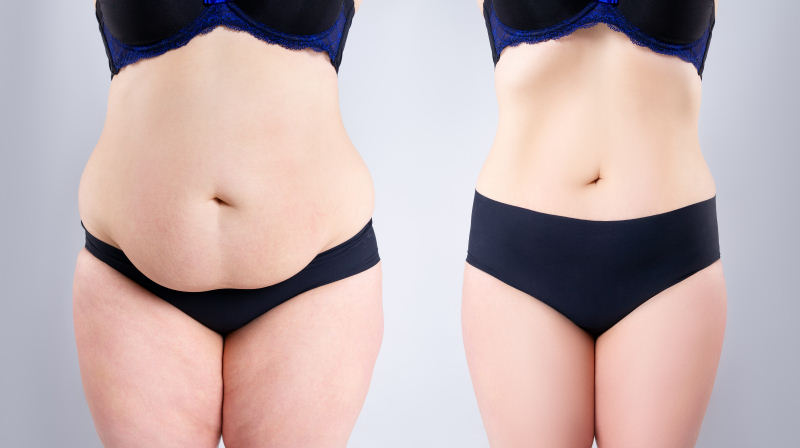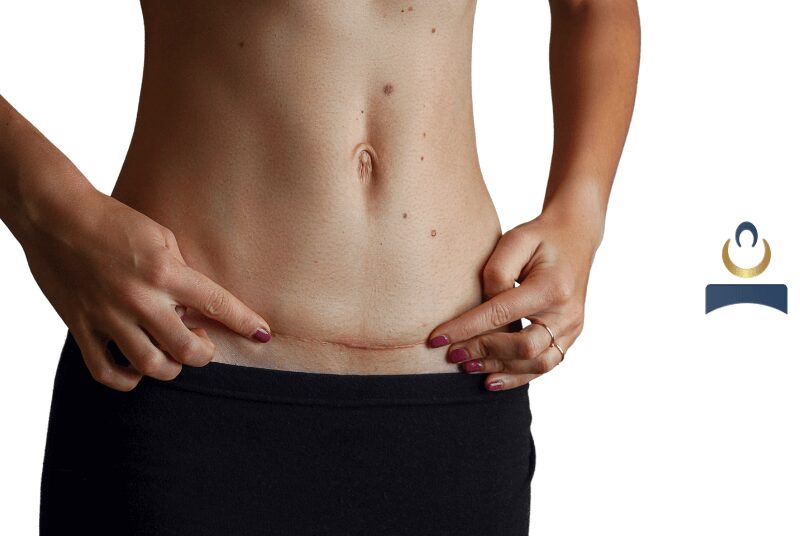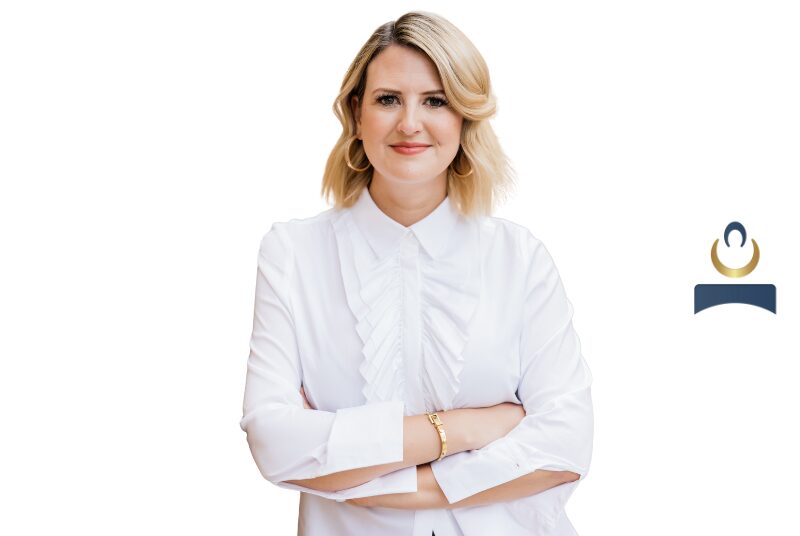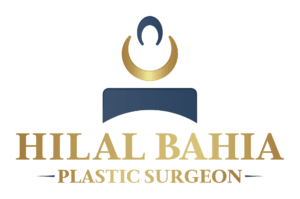
A tummy tuck can be helpful in patients who have completed their family or lost significant weight through diet and exercise or bariatric surgery. The aim of surgery is to remove the loose overhanging skin, to flatten and tighten the tummy, and if required to correct muscle separation. The procedure can be combined with hernia repair if required. Liposuction may be carried out at the same time.

A Mini-Tummy Tuck may be appropriate for small areas of excess and bulge in the lower tummy. The scars are located in the skin crease above the pubic area and extends out to the hips and around the belly button.
A Fleur-de-Lis abdominoplasty may be recommended for patients who have lost a large amount of weight and have both a vertical and transverse excess of skin and fat.
This procedure results in a transverse scar as well as a vertical scar extending up the midline. Occasionally, drains are required, but these are usually avoided if possible.

Elasticated stockings and calf pumps are used to reduce the risk of deep vein thrombosis during and after surgery. Initially, the hips and knees are usually maintained in a flexed position due to the tightness in the lower abdominal scar, however, straightening up is usually encouraged in the first 24-48 hours.

The patient usually stays one or two nights in hospital.
Following discharge from hospital, simple painkillers are usually all that is required.
The dressings allow for showering the following day and are removed by the specialist nurses in the dressings clinic after a week.
Your plastic surgeon usually sees you at six to eight weeks after surgery in order to ensure all is well and that you are happy with your result.

There are a number of different techniques of abdominoplasty, or tummy tuck, available depending on the patient’s wishes and clinical indication.
An abdominoplasty can remove excess skin, old or poor scars (such as from an appendicectomy or Caesarian section), stretch marks, and fat from the lower abdomen. The rectus (six-pack) muscles of the abdominal wall may also be tightened at the same time, if needed.
Excess tissue may often be caused by pregnancy, which can stretch the skin and weaken the rectus muscles, while also pulling the muscles apart (divarication of the recti). These problems may also be seen after weight loss. Diet and exercise often fail to tighten the abdominal wall skin.
The ideal patient is someone whose weight is normal, particularly after a large amount of weight loss. Abdominoplasty is not an ideal operation for people who are overweight wishing to lose weight.
Different abdominoplasty techniques exist to address different areas of tissue excess. The best approach to address an individual’s needs will be discussed during your consultation.



A classic, full tummy tuck is recommended for patients who have significant loose skin and excess fat in the lower abdomen. There may also be separation of the rectus muscles, which can occur after large or twin pregnancies.
The operation is carried out under general anaesthetic, taking 2-3 hours, and usually requires one to two nights in hospital. The stitches are usually dissolving and drains are not usually required.
The scars will be from hip to hip and around the umbilicus (belly button). The excess skin and fat are cut away from the umbilicus to just above the pubic hairline. If required, the muscles above and below the umbilicus may also be tightened at the same time.
Ideally, women considering this procedure, should wait until after their family is complete and are not considering further pregnancies before undergoing this procedure, in order to maximise the benefits of the surgery.
All the skin and fat below the umbilicus can be removed in a standard abdominoplasty.
This results in a scar across the lower abdomen and a scar around the umbilicus.
This may be recommended for patients with only a small amount of excess skin and fat in the lower abdomen. A general anaesthetic is usually still required, but this may be possible as day surgery.
A wedge of skin and fat is removed from the lower abdomen leaving a horizontal scar just above the pubic hairline.
There is usually no scar around the umbilicus, which may be stretched/pulled downwards and may become a different shape. A mini abdominoplasty will give a smaller effect than a full abdominoplasty.


This requires a mid-line vertical incision from the top of the abdomen down and around the umbilicus, and to meet the vertical scar above the pubic hairline.
This may be recommended for patients who have a large amount of excess/loose skin and fatty tissue in the abdominal flanks, such as after losing a great deal of weight.
An apronectomy is usually recommended for patients who have a large pannus (a large excess of skin and fat hanging down over the pubic area), which may be left behind after massive weight loss, such as after a gastric bypass operation, and where the patient may remain significantly overweight.
Only the excess skin and fat is removed in order to minimise the operative time under an anaesthetic and the associated risks. The scar is long and extends from one side of the abdomen to the other. Often the umbilicus (belly button) may have to be sacrificed during this procedure.




© 2024 Hilal Bahia | Website by Internet Creation Ltd